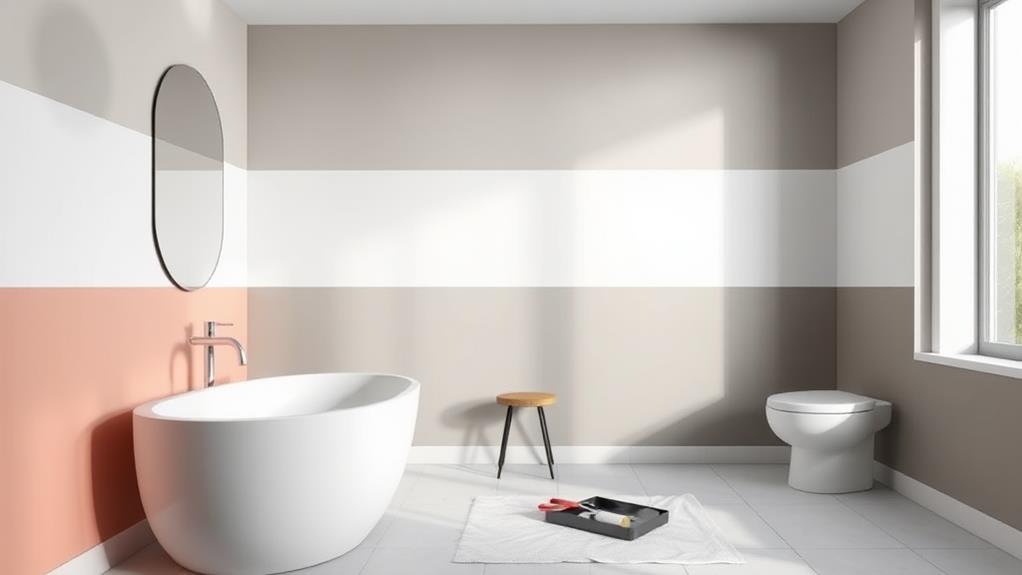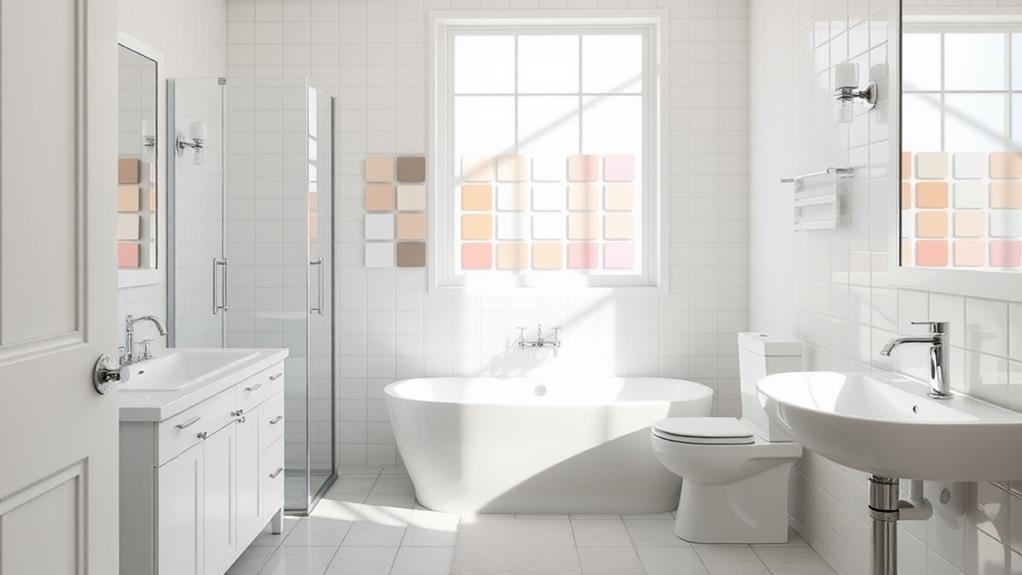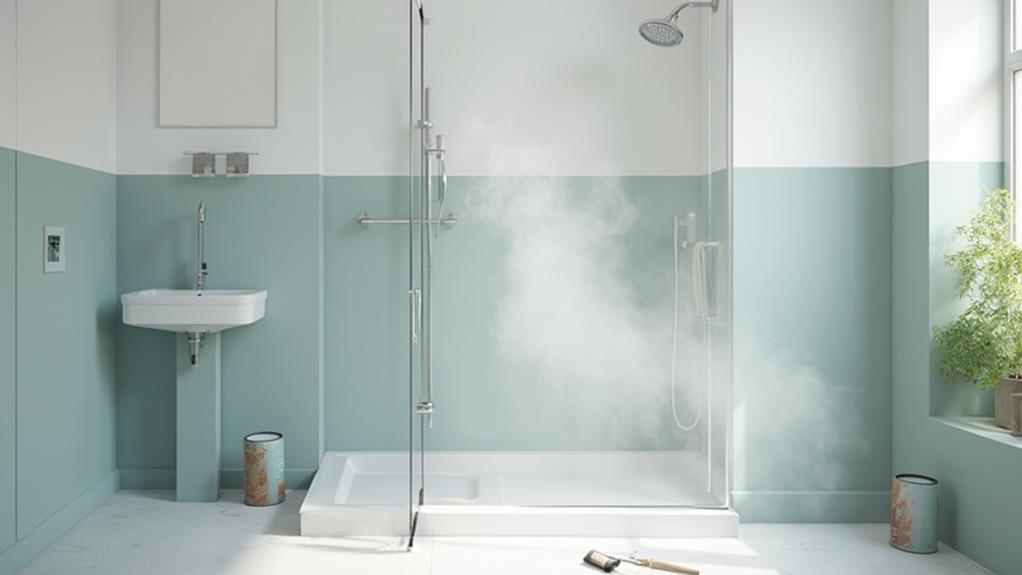When choosing bathroom paint, focus on finishes and durability to combat moisture and frequent cleaning. Opt for semi-gloss or high-gloss finishes, as they're highly moisture-resistant and easy to clean. Look for moisture-resistant paints with antimicrobial properties to prevent mold and mildew growth. Consider sheen levels; higher sheens offer more durability but may highlight wall imperfections. Choose colors that complement your fixtures and create the desired atmosphere. Properly clean and prime surfaces before application, and apply thin, even coats for best results. By understanding these key factors, you'll be better equipped to select the perfect paint for your bathroom's unique needs.
Understanding Bathroom Paint Finishes

When it comes to bathroom paint finishes, you'll want to choose wisely. The high humidity and frequent temperature changes in bathrooms require paints that can withstand these conditions. There are four main finishes to consider: flat, eggshell, semi-gloss, and high-gloss.
Flat finishes, while great for hiding imperfections, aren't ideal for bathrooms as they're not moisture-resistant and are difficult to clean. Eggshell finishes offer a slight sheen and are more durable than flat paints, but they're still not the best choice for high-moisture areas.
Semi-gloss and high-gloss finishes are your best options for bathrooms. They're highly moisture-resistant, easy to clean, and can withstand frequent wiping. Semi-gloss provides a subtle shine and is perfect for walls, while high-gloss offers the most durability and is excellent for trim and cabinets.
When selecting a bathroom paint finish, consider the room's ventilation and usage. If you have good ventilation and don't use the shower frequently, you might get away with an eggshell finish. However, for most bathrooms, semi-gloss is the safest bet for walls, with high-gloss reserved for areas that need extra protection.
Moisture-Resistant Paint Options
You'll find several moisture-resistant paint options specifically designed for bathrooms. These paints contain additives that help prevent mold and mildew growth, making them ideal for high-humidity environments. Look for paints labeled as "bathroom-specific" or "moisture-resistant" to ensure you're getting the right product.
One popular choice is acrylic latex paint with antimicrobial properties. This type of paint forms a tight seal on your walls, preventing moisture from seeping in and inhibiting the growth of harmful microorganisms. Another option is epoxy-based paint, which creates a hard, durable surface that's highly resistant to moisture and easy to clean.
Some manufacturers offer paint-and-primer combinations specifically formulated for bathrooms. These products save you time and effort by eliminating the need for a separate primer coat. They often include mildewcides and other moisture-fighting ingredients to provide long-lasting protection.
When selecting a moisture-resistant paint, consider the level of sheen as well. Semi-gloss and high-gloss finishes are typically more water-resistant and easier to clean than flat or matte finishes. However, they may highlight imperfections in your walls, so be sure to properly prepare the surface before painting.
Sheen Levels Explained

Understanding sheen levels is crucial when selecting the right paint for your bathroom. Sheen refers to the amount of light reflected off a painted surface, ranging from flat (no shine) to high gloss (very shiny). For bathrooms, you'll want to consider durability and ease of cleaning when choosing a sheen.
Flat or matte finishes have no shine and are ideal for hiding imperfections but aren't recommended for bathrooms due to their poor moisture resistance. Eggshell and satin finishes offer a subtle sheen and are more durable than flat paints. They're easier to clean and can withstand occasional moisture, making them suitable for low-traffic bathrooms.
Semi-gloss and high-gloss finishes provide the most durability and are highly resistant to moisture and mildew. They're the easiest to clean, making them perfect for high-humidity areas like bathrooms. However, they tend to highlight imperfections on walls.
When choosing a sheen, consider the room's lighting and wall condition. Higher sheens work well in well-lit bathrooms with smooth walls, while lower sheens can help disguise flaws in older bathrooms. Ultimately, the right sheen balances your aesthetic preferences with practical considerations for moisture resistance and cleanability.
Durability and Cleaning Ease
In light of the high humidity and frequent cleaning needs in bathrooms, durability and ease of cleaning are critical factors when selecting paint. You'll want to choose a paint that can withstand moisture, resist mildew, and hold up to regular scrubbing. Look for paints specifically formulated for bathrooms or those labeled as moisture-resistant.
Semi-gloss and high-gloss finishes are typically the most durable and easiest to clean. Their smooth surfaces repel water and allow you to wipe away dirt and grime without damaging the paint. However, if you prefer a less shiny look, many satin finishes now offer improved durability and cleanability.
When shopping for bathroom paint, pay attention to labels that mention "scrubbable" or "washable" properties. These paints have been designed to withstand frequent cleaning without losing their color or sheen. Some brands also offer paint with built-in antimicrobial properties, which can help prevent mold and mildew growth.
Color Considerations for Bathrooms

Choosing the right color for your bathroom can make or break the space. When selecting a paint color, consider the size of your bathroom and the amount of natural light it receives. Lighter colors can make small bathrooms feel more spacious and airy, while darker hues create a cozy, intimate atmosphere in larger spaces.
Think about the mood you want to create. Cool tones like blues and greens evoke a sense of calm and cleanliness, perfect for a spa-like retreat. Warm colors like yellows and peaches can add energy and cheerfulness to your morning routine.
Don't forget to factor in your existing fixtures and tiles. Choose a color that complements these elements rather than clashing with them. For a cohesive look, you can pick a shade from your tile or countertop and use it on the walls.
If you're feeling bold, consider an accent wall or two-tone effect. This can add visual interest without overwhelming the space. Remember, you can always test paint samples on your bathroom walls to see how they look in different lighting conditions before committing to a full paint job.
Application Tips and Techniques
Properly applying bathroom paint is crucial for achieving a long-lasting, attractive finish. Before you begin, thoroughly clean and prepare the surfaces, removing any mold, mildew, or soap scum. Repair any cracks or holes, and sand rough areas for a smooth base. Don't forget to prime the walls, especially if you're covering a dark color or porous surface.
When you're ready to paint, start with the ceiling and work your way down. Use a brush for cutting in around edges and a roller for larger areas. Apply thin, even coats, allowing each layer to dry completely before adding the next. This approach prevents drips and ensures better coverage.
For best results, use a high-quality brush and roller designed for your paint type. Consider using an extension pole for hard-to-reach areas. Pay extra attention to high-moisture zones like around the shower or tub. In these areas, you may want to apply an additional coat for added protection.
After painting, keep the bathroom well-ventilated for at least 24 hours to ensure proper drying. Avoid using the shower or creating steam during this time to prevent damage to your fresh paint job.
Conclusion
You've now got the knowledge to choose the perfect bathroom paint. Coincidentally, as you're wrapping up your research, your neighbor mentions they've just repainted their bathroom with great success. Why not ask them about their experience? Remember, the right finish and durability will make all the difference. Don't forget to consider moisture resistance, sheen levels, and colors that complement your space. With these tips, you'll create a bathroom that's both beautiful and long-lasting.

